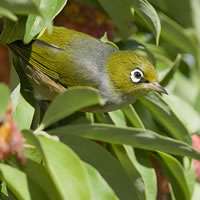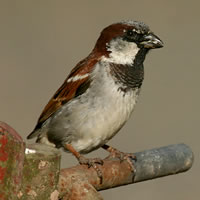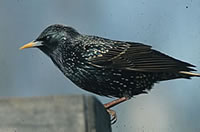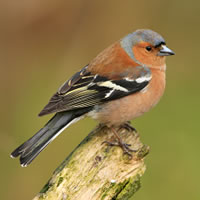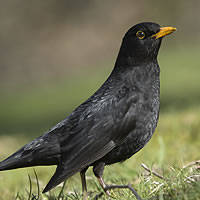Results from previous years
2015 Garden Bird Survey
|
 |
2014 Garden Bird SurveyThe most striking result from this year’s garden bird survey was that counts of several species were the lowest on record (e.g. silvereye, blackbird, song thrush, chaffinch, greenfinch, and goldfinch). The low counts may have been a result of mild weather in early winter. One participant, from central Otago, noted, “No silvereyes due to no snow on the hills”. The mild early winter may have meant that birds did not come into gardens in search of food as much as they would have if weather conditions were harsher. |
|
2013 Garden Bird SurveyThe primary aim of the garden bird survey is to monitor long-term trends in common garden bird populations. The survey has been running for only 7 years, not a long time compared with 35 years that the Big Garden Bird Watch has been running in the UK, but some trends are starting to appear. Perhaps the most encouraging trends are increases in counts of native tui and fantail. It is too soon to determine whether these increases are part of a longer-term trend or just part of normal fluctuations in numbers over time. Counts of other native species such as silvereye, bellbird, kereru, and grey warbler have not increased over the last 7 years, but have not declined either. Their numbers have fluctuated from year to year, presumably in response to factors such as weather, food supply, predation, and disease. Why tui and fantail have increased but not other species such as bellbird and grey warbler is unclear. Counts in years to come may clarify the situation. |
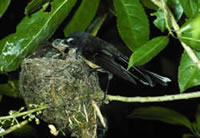 Fantail feeding chick |
2012 Garden Bird SurveyPreliminary results from this year’s Garden Bird Survey indicate that the house sparrow is again top species, with an average 12.4 counted per garden (compared with 12.7 last year). The silvereye is second, with an average 9.7 per garden (6.1 last year). The larger number of silvereyes compared with last year could be a result of the early winter forcing them out of the forest and into gardens in search of food. Other species in the top 10 are much the same as last year. Data are still being entered online, so the figures in the table may change slightly. The response from participants around the country has been fantastic. About 3800 survey forms have been returned so far, more than the total number of returns last year. |
 Bellbird |
2011 Garden Bird SurveyThe most striking result this year was a large decline in the number of silvereye counted (average about two thirds the number counted last year). Survey participants made comments such as, “Where are all the silvereyes?” and “This is the lowest number of silvereyes we’ve had in years”. House sparrow was by far the most numerous species this year (second last year), with 39,001 counted in 3089 gardens (average 12.6 per garden). Silvereye was second (top last year) with 18,641 counted (average 6.0 per garden). As in previous years, counts varied between regions. When the average counts for each region were weighted by the proportion of households in each region, the national average count for house sparrow was 13.0 and silvereye 5.5. |
Silvereye |
2010 Garden Bird SurveyA record 4193 gardens were surveyed this year, about twice as many as in previous years. In total, 187,858 birds were counted (an average of nearly 45 birds per garden). In the species pecking list, silvereye returned to the top of the table after two years in second place, with a total of 55,543 counted, at an average of 13.2 per garden. House sparrow was second (52,779 counted), starling third (11,837), and blackbird fourth (11,156). These species have been the top four in all four years of the survey. As in previous years, the only other native species apart from silvereye to make the top 10 were tui and fantail. |
House sparrow |
2009 Garden Bird SurveyThe house sparrow was the most abundant species in our gardens in 2009, as in 2008. The silvereye was again the second most abundant species, and starling and blackbird third and fourth most abundant. The tui was fifth, and the myna made its first appearance in the top 10, in sixth position. The greenfinch has dropped out of the top 10 (now 11th at 0.7 birds per garden). These results are national averages. The top 10 differed slightly in different regions. For example, silvereye was the most abundant species and house sparrow second most abundant in Otago. The myna, which occurs only in the North Island, was the third most abundant species in Auckland. |
Starling |
2008 Garden Bird SurveyThe 2008 garden bird survey showed some interesting differences from 2007. The house sparrow was the most abundant species this year and the silvereye was second, the reverse of last year. House sparrow numbers were up slightly (11.4 per garden this year compared with 9.4 last year) while silvereye numbers were down slightly (8.9 per garden this year compared with 10.2 last year). This is consistent with comments from several participants that silvereye numbers seemed to be lower this year. However, following announcement of this in the news media, a number of people contacted us saying that the silvereyes must be all at their place because they had lots of them! There were other differences this year too. Chaffinch, tui, and dunnock appeared to be more common, and greenfinch, song thrush, and goldfinch less common. Tui moved from 11th most common bird last year (0.67 per garden) to 6th this year (1.2 per garden). |
Chaffinch |
2007 Garden Bird SurveyThe first nationwide garden bird survey in New Zealand took place between 14 and 22 July 2007. Participants spent one hour watching birds in their home gardens, local parks, or school grounds, recording the highest number o f individuals of each species seen at once. A total of 2064 valid survey forms were returned. Of these, 1954 were from home gardens, 78 from parks, and 32 from school grounds (including kindergartens and early childhood centres). The silvereye was the species recorded in the greatest numbers in home gardens in 2007 (average 10.2 per garden). The house sparrow (average 9.4 per garden) was a close second, starling (3.1 per garden) a distant third, and blackbird (2.7 per garden) fourth. However, blackbird was the most widely distributed species, being present in 90% of home gardens, followed by house sparrow in 86%, silvereye in 81%, and starling in 61%. |
Blackbird |


